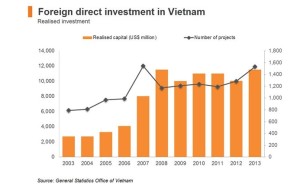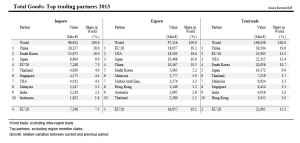Overview
On the 2nd of December 2015, after almost three years and 14 rounds of negotiations, President Donald Tusk, President Jean-Claude Juncker and Prime Minister of Vietnam Nguyễn Tấn Dũng announced the conclusion of the negotiations of the EU-Vietnam Free Trade Agreement (EVFTA). The EVFTA is a new-generation Free Trade Agreement between Vietnam and the EU. On 26 June 2018, the EVFTA was split into two separate agreement, one on trade and one on investment. In August 2018, EU and Vietnam completed the legal review of the EVFTA and the EU – Vietnam Investment Protection Agreement (EVIPA). The EVFTA needs to be ratified by the European Commission and European Parliament while the EVIPA must be additionally ratified by the Parliament of each EU member countries.
On 30th June 2019, EU Commissioner for Trade Mrs. Cecilia Malmstrom, together with Romanian Minister in charge of business, commerce and business Mr. Stefan-Radu Oprea represented the EU to sign the EU – Vietnam FTA (EVFTA) in Hanoi.
Both the EVFTA and EVIPA are said to bring the best advantages and benefits ever for enterprises, employees, and consumers in both the EU and Vietnam. Vietnam’s GDP is expected to increase by 10-15 per cent and exports are predicted to rise by 30-40 per cent in the next 10 years. Meanwhile, the real wages of skilled labourers could rise up to 12 per cent, while the real salaries of common workers could increase 13 per cent. Once the EVFTA is ratified and implemented, and once Government policies and institutional reforms begin to take effect, Vietnam’s business activities will boom. However, issues still remain. In this chapter, EuroCham’s Legal Sector Committee will raise the issues relevant to their particular industries, and make specific recommendations in order to address these concerns.
Legal environment
General market access for goods and services
The EVFTA is the most comprehensive and ambitious trade and investment agreement that the EU has ever concluded with a developing country in Asia. It is the second agreement in the ASEAN region, after Singapore, and it will intensify bilateral relations between Vietnam and the EU. Vietnam will have access to a potential market of more than 500 million people and a total GDP of US$15,000 billion (accounting for 22 per cent of global GDP). Meanwhile, exporters and investors from the EU will have further opportunities to access one of the largest and fastest-growing countries in the region. According to a report released in early 2017 covering 134 cities worldwide, Hanoi and Ho Chi Minh City are ranked among the top 10 most dynamic cities due to their low costs, rapid consumer market expansion, strong population growth and transition towards activities attracting significant amounts of Foreign Direct Investment (FDI). According to the World Bank, Vietnam has one of the fastest growing economies in the world—7.1% GDP growth in 2018, and 6.7% at the mid-point of 2019. To put that in perspective, Vietnam’s GDP is growing at almost twice the rate of the USA.
In addition, Vietnam has the fastest-growing middle class in the region. It is predicted to almost double in size between 2014 and 2020 (from 12 million to 33 million people). Vietnam’s super-rich population is also growing faster than anywhere else, and there is no doubt that it will continue to rise over the next ten years.
Market access for goods
Nearly all customs duties – over 99 per cent of the tariff lines – will be eliminated. The small remaining number will be partially liberalised through duty-free quotas. As Vietnam is a developing country, it will liberalise 65 per cent of the value of EU exports to Vietnam, representing around half of the tariff lines, at entry into force. The remaining duties will be eliminated over the next ten years. This is an unprecedented, far-reaching tariff elimination for a country like Vietnam, proving its aspiration for deeper integration and trading relations with the EU.
Meanwhile, the EU agreed to eliminate duties for 84 per cent of the tariff lines for goods imported from Vietnam immediately at the entry into force of the FTA. Within 7 years from the effective date of the FTA, more than 99 per cent of the tariff lines will have been eliminated for Vietnam. This is a wider reduction compared with the 95 per cent of the tariff lines that the former TPP countries offer to Vietnamese imports. In the ASEAN region, Vietnam is the top country exporting goods to the EU. However, the market share of Vietnam’s products in the EU is still small. As a result of the EVFTA, the sectors set to benefit most are main export sectors that used to be subject to high tariffs from the EU including textiles, footwear, and agricultural products. The EU is also a good point for Vietnam to reach other further markets.
Vietnam will benefit more from the EVFTA compared with other FTAs, since Vietnam and the EU are considered to be two supporting and complementary markets: Vietnam exports goods that the EU cannot or does not produce itself (i.e., fishery products, tropical fruits, etc.) while the products imported from the EU are also those Vietnam does not produce domestically, including machinery, aircrafts and pharmaceutical products.
With better market access for goods from the EU, Vietnamese enterprises could source EU materials, technology, and equipment at a better quality and price. This, in turn, will improve their own product quality and ease Vietnam’s burden of over-reliance on its other main trading partners.
The EVFTA is considered as a template for the EU to further conclude FTAs with different countries in the ASEAN region with the aim of concluding a region to region FTA once there is a sufficient critical mass of FTAs with individual ASEAN countries. This process could take between 10-15 years. Thus, Vietnam should take advantage of this window of opportunity before FTAs with others in the region are concluded and take effect to become a regional hub.
Market access for EU service providers
Although Vietnam’s World Trade Organisation (WTO) commitments are used as a basis for the services commitments, Vietnam has not only opened additional (sub)sectors for EU service providers, but also made commitments deeper than those outlined in the WTO, offering the EU the best possible access to Vietnam’s market. (Sub)sectors that are not committed under the WTO, but under which Vietnam has made commitments, include: Interdisciplinary Research & Development (R&D) services; nursing services, physiotherapists and para-medical personnel; packaging services; trade fairs and exhibitions services and building-cleaning services.
When these services reach international standards, Vietnam has a chance to export high-quality services, resulting in not only an increase in export value but also export efficiency, thus helping to improve the trade balance.
Government procurement
Vietnam has one of the highest ratios of public investment-to-GDP in the world (39 per cent annually from 1995). However, until now, Vietnam has not agreed to its Government procurement being covered by the Government Procurement Agreement (GPA) of the WTO. Now, for the first time, Vietnam has undertaken to do so in the EVFTA.
The FTA commitments on Government procurement mainly deal with the requirement to treat EU bidders, or domestic bidders with EU investment capital, equally with Vietnamese bidders when the Government purchases goods or requests a service worth over the specified threshold. Vietnam undertakes to follow the general principles of National Treatment and Non-discrimination. It will publish information on intended procurement and post-award information in Báo Đấu Thầu – Public Procurement Newspaper – and on information on procurement system at muasamcong.mpi.gov.vn and the official gazette in a timely manner, allow sufficient time for suppliers to prepare for and submit requests for participation and responsive tenders and maintain the confidentiality of tenders. The FTA also requires its Parties to assess bids based on fair and objective principles, evaluate and award bids only based on criteria set out in notices and tender documentation and create an effective regime for complaints and settling disputes. These rules require Parties to ensure that their bidding procedures match the commitments and protect their own interests, thus helping Vietnam to solve its problem of bids being won by cheap but low-quality service providers.
Government procurement of goods or services, or any combination thereof, that satisfy the following criteria falls within the scope of the FTA Government Procurement rules:
Investment Dispute Settlement
This is now covered in the IPA. In disputes regarding investment (for example, expropriation without compensation or discrimination of investment), an investor is allowed to bring the dispute to the Investment Tribunal for settlement. To ensure the fairness and independence of the dispute settlement, a permanent Tribunal will be comprised of 9 members: 3 nationals each appointed from the EU and Vietnam, together with 3 nationals appointed from third countries. Cases will be heard by a 3-member Tribunal selected by the Chairman of the Tribunal in a random and unpredictable way. This is also to ensure consistent rulings in similar cases, thus making the dispute settlement more predictable. The IPA also allows a sole Tribunal member where the claimant is a small or medium-sized enterprise or the compensation of damaged claims is relatively low. This is a flexible approach considering that Vietnam is still a developing country.
In case either of the disputing parties disagrees with the decision of the Tribunal, it can appeal it to the Appeal Tribunal. While this is different from the common arbitration proceeding, it is quite similar to the 2-level dispute settlement mechanism in the WTO (Panel and Appellate Body). We believe that this mechanism could save time and cost for the whole proceedings.
The final settlement is binding and enforceable from the local courts regarding its validity, except for a five-year period following the entry into force of the FTA for Vietnam (please refer to further comments in the Chapter on Judicial Recourse).
Conclusion
The EVFTA, once ratified, will create sustainable growth, mutual benefits in several sectors and be an effective tool to balance trade relations between the EU and Vietnam. Vietnam is working hard to meet the high standards set out in the FTA, and is currently offering greater opportunities for foreign businesses in preparation for the FTA’s finalisation. It is now time for foreign investors to start their business plans and grasp the upcoming clear opportunities.
***
Please do not hesitate to contact Dr. Oliver Massmann under omassmann@duanemorris.com or any other lawyer listed in our office list if you have any questions on the above. Dr. Oliver Massmann is the General Director of Duane Morris Vietnam LLC.
THANK YOU VERY MUCH!


